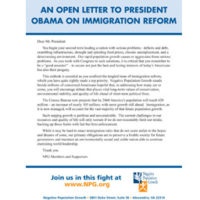Little Known Presidential Population Leadership
- Otis L. Graham, Jr
- January 19, 2013
- Forum Papers
- Forum Paper
- 0 Comments
It is to be expected that a social change that momentous would come to the attention of society’s leaders, including our president. These numbers did concern Harry Truman, but not until he left the White House could he convince himself it was government’s business. The pathway to both concern and engagement for President Dwight Eisenhower was also steep and cluttered with reservations.
This was a decade filled with the challenges of the Cold War, which all of Washington was intensely preoccupied with winning. How could we win if the impoverished Third World was hampered in economic development by relentless population growth? Several members of the Senate Foreign Relations Committee pressed Eisenhower to appoint a special group to study the work of the rudderless military assistance program. Ike agreed, and as chair appointed Wall Street investor William Draper, who just happened to be a close friend of John D. Rockefeller III, who just happened to be a passionate worrier about population growth and supporter of birth control, who converted Draper, whose report to Eisenhower endorsed an expansion of U.S. foreign aid to include contraceptive technology and education. Eisenhower’s first thought about government engagement with population size was negative, and he forcefully rebuffed this suggestion: “I cannot imagine anything more emphatically a subject that is not a proper political or governmental function….” But Draper and his Report were persuasive, and led to an expansion of the tools employed in American foreign aid to include birth control. Eisenhower explained his change of mind in a September, 1963 article in the Saturday Evening Post: “It may be that I was carrying that conviction too far…. We should tell [aid receiving] nations how population growth threatens them and what can be done about it.”
Just months earlier, President John F. Kennedy, responding to arguments from his own State Department, announced his view that population increases [abroad] “were of serious concern.” Foreign aid legislation under Kennedy began to include family planning assistance, and President Lyndon Johnson, pressed by Secretary of State Dean Rusk, added this sentence to his State of the Union Address in l965: “I will seek new ways to use our knowledge to help deal with the explosion in world population.” Just months before, in 1964, Eisenhower convinced Harry Truman – who had also changed his mind – to join him in serving as honorary co-chairs of Planned Parenthood.
How many presidents was that, who opened this new policy issue involving human fertility? Three in a row, so far – four, if we count ex-president Truman’s public statements. Congressional leadership was also forthcoming. Senator Ernest Gruening, braver than his colleagues, held Senate hearings in 1965 on birth control availability for Americans and opened the hearings with a supporting letter from Eisenhower. The idea gained momentum that the U.S. needed to aim part of its foreign aid toward lowering birth rates in the Third World, and also needed to support birth control access for American w omen. These new population policy impulses were strengthened by the enormous impact of Paul Ehrlich’s 1968 book The Population Bomb. The environmental movement quickly took to the idea that curbing population growth was a central key to the protection of nature, and learned the I=PAT formula created by Ehrlich and John Holdren (Environmental Impact (I) = (P)Population X (A) Affluence X (T)Technology). When Earth Day annually gathered crowds of young and green people beginning in 1970, population limitation and environmentalism were routinely linked. British writer C. P. Snow ignited a rhythmic chant in a Midwestern university crowd on the first Earth Day when he responded to their question: “What is the Cause?” with the words: “Peace! Food! No More people than the earth can take!”
Graham was Professor Emeritus of history at the University of California, Santa Barbara. He was the author or editor of more than fifteen books, including “Debating American Immigration, 1882-Present” (with Roger Daniels) and “Environment Politics and Policy, 1960s to 1990s”.

